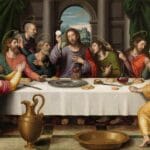Stepping into a Catholic church, your gaze might be drawn to a radiant, often golden, sun-like object displayed prominently. This captivating vessel is called a monstrance, and it holds a significance far deeper than mere decoration. Join us as we delve into the intriguing world of the monstrance, exploring its history, symbolism, and enduring importance in Catholic tradition.
Facts about the Monstrance
The monstrance, far from being just a beautiful artifact, serves as a testament to a centuries-old tradition and a profound belief at the heart of Catholicism: the Real Presence of Christ in the Eucharist.
Origin and Purpose
The term “monstrance” finds its roots in the Latin word “monstrare,” meaning “to show” or “to display.” This etymology offers a glimpse into the very essence of the monstrance, which is to present the consecrated Eucharistic Host for veneration.
Historical Development
The emergence of the monstrance can be traced back to the 13th century, a period marked by the rising popularity of Eucharistic processions and the Feast of Corpus Christi. Early monstrances drew inspiration from reliquaries (containers for relics) and pyxes (containers specifically designed for the Eucharist). Over time, monstrances underwent a transformation, evolving from simpler designs into the elaborate and ornate forms we often see today.
Design and Usage
Monstrances exhibit a striking diversity in form and size.
- Portable Monstrances: Often taking the shape of a sunburst on a stand, these are designed to be carried by priests, particularly during processions. The sunburst design, far from being merely aesthetic, carries profound symbolism, representing the radiant glory of Christ. Many are topped with a cross, further emphasizing their religious significance.
- Fixed Monstrances: These larger, stationary monstrances are typically found in dedicated side chapels or areas specifically designed for Eucharistic adoration. These monstrances often boast more elaborate designs, featuring intricate crowns and other decorative elements. The crown, a powerful symbol in itself, represents Christ as the King of Kings.
The variation in design, from the portable sunburst to the grand fixed monstrances, speaks volumes about the reverence accorded to the Eucharistic Host within the Catholic tradition.
Unique Insights
The study of monstrances opens up fascinating avenues of exploration:
- Theological and Liturgical Significance: The practice of Eucharistic adoration, with the monstrance at its center, offers rich insights into Catholic theology and liturgy.
- Historical Impact: Examining notable monstrances throughout history reveals their influence on Catholic devotion and artistic expression.
- Contemporary Relevance: Even in the modern world, monstrances continue to play a vital role in Catholic practice, fostering a tangible and visual connection to the divine.
What Does the Monstrance Symbolize?
The monstrance’s symbolism extends far beyond its function as a container. It serves as a visual testament to the Catholic belief in the Real Presence of Christ in the Eucharist.
Vessel of Divine Presence
At its core, the monstrance represents the belief that the consecrated Eucharistic host is not merely bread but is transformed into the actual body of Christ. This belief in transubstantiation lies at the very heart of Catholic theology.
Focal Point for Adoration
The monstrance serves as a tangible focal point for Eucharistic adoration, drawing the gaze and the heart towards the mystery of Christ’s presence. Its often elaborate design, far from being mere ornamentation, serves to enhance this focus, inviting contemplation and prayer.
Symbol of Sacrifice and Grace
In its display of the Eucharistic host, the monstrance embodies the sacrifice of Christ on the cross and the grace that flows from that sacrifice. It serves as a visible reminder of God’s love for humanity.
Artistic Expression of Devotion
The artistry often displayed in monstrances throughout history speaks volumes about the devotion they represent. Each intricate detail, each carefully chosen gemstone, reflects the deep reverence felt by those who crafted and commissioned these sacred vessels.
Why Can’t You Touch the Monstrance?
The prohibition against touching the monstrance stems from a deep-seated reverence for the Eucharist and a desire to protect its sanctity.
Respect for the Body of Christ
For Catholics, touching the monstrance would be tantamount to casually handling the body of Christ. The act would be deemed deeply disrespectful, given the profound significance attached to the Eucharist.
Preservation of a Sacred Object
Monstrances, often crafted from precious metals and adorned with delicate details, are themselves objects of art and historical significance. Limiting physical contact helps to preserve these valuable artifacts for future generations.
Protection from Contamination
Just as one might take care to handle food with clean hands, so too is the consecrated host protected from potential contamination. The restriction against touching the monstrance extends to this concern, ensuring the purity of the sacrament.
Liturgical Guidelines and Protocols
The Catholic Church has established specific liturgical guidelines and protocols governing the handling of sacred objects, including the monstrance. These rules, rooted in tradition and a deep respect for the Eucharist, dictate that only ordained priests and deacons are permitted to handle the monstrance.
Why is the Monstrance Like the Sun?
The visual imagery associated with the monstrance often evokes comparisons to the sun. This symbolic connection stems from the monstrance’s representation of Christ’s radiant presence.
Radiance of Christ
Just as the sun emanates light and warmth, the monstrance, in the eyes of the faithful, reflects the spiritual radiance of Christ. This radiance symbolizes his divine glory and the light he brings into the world.
Sunburst Symbolism
The frequent use of sunburst imagery in monstrance design reinforces this connection to the sun. The radiating rays surrounding the luna, where the host is placed, visually represent the emanating presence of Christ.
Connection to Christ
The monstrance, through its symbolism, acts as a conduit, drawing individuals closer to Christ. Just as people are naturally drawn to the warmth and life-giving properties of the sun, so too does the monstrance inspire a yearning for spiritual closeness with Christ.
Focal Point for Veneration
Both the sun and the monstrance command attention. One illuminates the physical world, while the other illuminates the spiritual realm. The monstrance, by displaying the Eucharist, becomes a focal point for veneration, inspiring awe and wonder.
Eucharistic Transformation
The sun’s energy sustains life on Earth, transforming and nurturing. Similarly, the monstrance represents the belief in the transformative power of the Eucharist. Through this sacrament, Catholics believe they receive spiritual nourishment and strength, just as the Earth receives sustenance from the sun.
What is a Monstrance Made Of?
The materials used in crafting a monstrance reflect the reverence accorded to the Blessed Sacrament it contains.
Precious Metals and Gemstones
Monstrances are typically made from precious metals, primarily gold or silver. The choice of these materials speaks to more than just aesthetic appeal. Gold and silver, associated with purity and value, symbolize the preciousness of the Eucharist.
Artistry and Craftsmanship
Many monstrances showcase exquisite craftsmanship, often adorned with intricate details, engravings, and even precious gemstones. This artistry serves not only to beautify but also to elevate the monstrance, reflecting the profound significance of the Eucharist it houses.
Luna and Ostensorium
While designs vary, two key elements are common to most monstrances:
- Luna: A crescent-shaped or circular receptacle, often made of glass and rimmed in gold or silver, the luna holds the consecrated host.
- Ostensorium: This is the larger, often highly decorative structure that surrounds and displays the luna. The ostensorium might feature sunburst designs, religious figures, or other symbolic elements.
What is Kept Inside the Monstrance?
The monstrance serves as a vessel for the consecrated Eucharistic host, the central element of the Catholic Mass.
The Consecrated Host
Catholics believe that during the Mass, through the words of consecration, the bread and wine used in communion are transformed into the actual body and blood of Christ. This transformation is known as transubstantiation. The consecrated host, therefore, is regarded with the utmost reverence.
Significance of the Monstrance
The monstrance plays a crucial role in safeguarding and displaying the consecrated host, particularly during Eucharistic Adoration. Its design allows for the host to be both protected and visible, facilitating prayer and contemplation.
Symbolism and Reverence
The elaborate design and precious materials often used in crafting monstrances underscore the significance placed on the Eucharist within the Catholic tradition. The monstrance serves as a visual reminder of Christ’s sacrifice and a powerful symbol of his presence among believers.
Who Can Hold the Monstrance?
Given the profound reverence accorded to the Eucharist, the Catholic Church has established guidelines regarding who may handle the monstrance.
Ordained Ministers
Typically, only ordained priests and deacons are authorized to touch and carry the monstrance. This restriction stems from their consecrated roles within the Church and the specific training they receive in handling sacred objects.
Respect and Reverence
Limiting who can handle the monstrance underscores the sacredness of the Eucharist and emphasizes the importance of treating it with the utmost respect. This practice is consistent with other liturgical practices within the Church designed to protect the sanctity of sacred objects and rituals.
Ongoing Dialogue
While the current understanding within the Church is clear on this matter, it is worth noting that theological interpretations can evolve over time. As with many aspects of religious tradition, ongoing discussions and studies among theologians may offer new perspectives. Any significant changes, however, would likely involve extensive dialogue and careful consideration from religious leaders.
What is the Meaning of Monstrance in the Bible?
The term “monstrance” does not actually appear in the Bible. The use of a monstrance developed later within the Catholic Church, emerging as a visual expression of theological beliefs surrounding the Eucharist.
Biblical Roots
While not explicitly mentioned, the concepts that underpin the monstrance’s significance can be traced to biblical teachings:
- Reverence for the Eucharist: The Gospels recount the institution of the Eucharist at the Last Supper, highlighting its importance within the Christian tradition (Matthew 26:26-28; Mark 14:22-24; Luke 22:19-20).
- Visual Symbols in Worship: The Bible makes use of visual symbols to convey spiritual truths, suggesting that physical objects can serve as aids to worship and understanding (Exodus 25:18-22; Revelation 1:12-16).
Evolution of Tradition
The monstrance stands as an example of how religious traditions can evolve and find expression in tangible forms. While not directly mentioned in scripture, the monstrance developed as a way to give visible form to the deeply held belief in the Real Presence of Christ in the Eucharist.
Why Do Catholics Pray in the Presence of a Monstrance?
For Catholics, praying before a monstrance is not about venerating an object but about entering into communion with Christ, who they believe is truly present in the consecrated host.
Belief in Transubstantiation
Understanding this practice requires understanding the doctrine of transubstantiation. Catholic teaching holds that during the Eucharist, the substance of the bread and wine used in communion is changed into the substance of Christ’s body and blood, while the outward appearance of bread and wine remains.
Real Presence and Adoration
Because of this belief in the Real Presence, Catholics approach the monstrance with profound reverence. Praying before a monstrance, then, becomes an act of adoration directed towards Christ himself.
Spiritual Benefits
Praying in the presence of the monstrance offers Catholics a number of spiritual benefits:
- Deeper Connection: The monstrance serves as a visual reminder of Christ’s sacrifice and a tangible manifestation of his presence, fostering a sense of closeness and connection.
- Contemplation and Reflection: The monstrance can facilitate a deeper contemplation of the mysteries of faith, such as Christ’s incarnation, death, and resurrection.
- Spiritual Consolation: Many Catholics find solace and comfort in the presence of the Eucharist, drawing strength and hope from their belief in Christ’s real presence.
What is the Difference Between a Monstrance and the Blessed Sacrament?
While often used interchangeably, a distinction exists between the terms “monstrance” and “Blessed Sacrament.”
Monstrance as Vessel
The monstrance, as we’ve explored, is the vessel—the ornate, often precious container designed specifically to hold and display the consecrated host.
Blessed Sacrament as Content
The Blessed Sacrament, on the other hand, refers to the consecrated Eucharistic host itself. It is the consecrated host, believed to be the body and blood of Christ, that is considered the Blessed Sacrament.
Analogy of Container and Contained
To clarify:
- The monstrance is the container, the reliquary designed to showcase and protect.
- The Blessed Sacrament is the content, the consecrated host believed to be Christ himself.
Importance of Both
Both the monstrance and the Blessed Sacrament hold deep significance within Catholic tradition. The monstrance, through its beauty and symbolism, points to the profound reverence afforded to the Blessed Sacrament, while the Blessed Sacrament itself remains at the heart of Catholic faith and practice.
Is Jesus in the Monstrance?
The answer to this question hinges on the central tenet of Catholic belief: transubstantiation.
Catholic Perspective: Real Presence
From a Catholic perspective, the answer is unequivocally yes. Catholics believe that during the Eucharist, the bread and wine are transformed into the body and blood of Christ. This transformation is not symbolic but real, even though the outward appearances of bread and wine remain. Since the monstrance holds the consecrated host, Catholics believe that Jesus, in the form of the Eucharist, is truly present within it.
Basis for Adoration
This belief in the Real Presence forms the foundation for the practice of Eucharistic Adoration. Catholics do not simply venerate a symbol; they direct their prayers and adoration towards Christ himself, present in the Eucharist.
Importance of Understanding
It is essential to approach this question with sensitivity and respect for different beliefs. While many Christians hold varying understandings of the Eucharist, the belief in the Real Presence and the reverence given to the monstrance remain central to Catholic faith and practice.


![A Historical Overview of the Church: Tracing Its Evolution Through the Ages [History of the Church Summary] history-of-the-church-summary_2](https://www.lolaapp.com/wp-content/uploads/2023/12/history-of-the-church-summary_2-150x150.jpg)










1 thought on “Monstrance: Fascinating Facts About This Sacred Vessel”
Comments are closed.